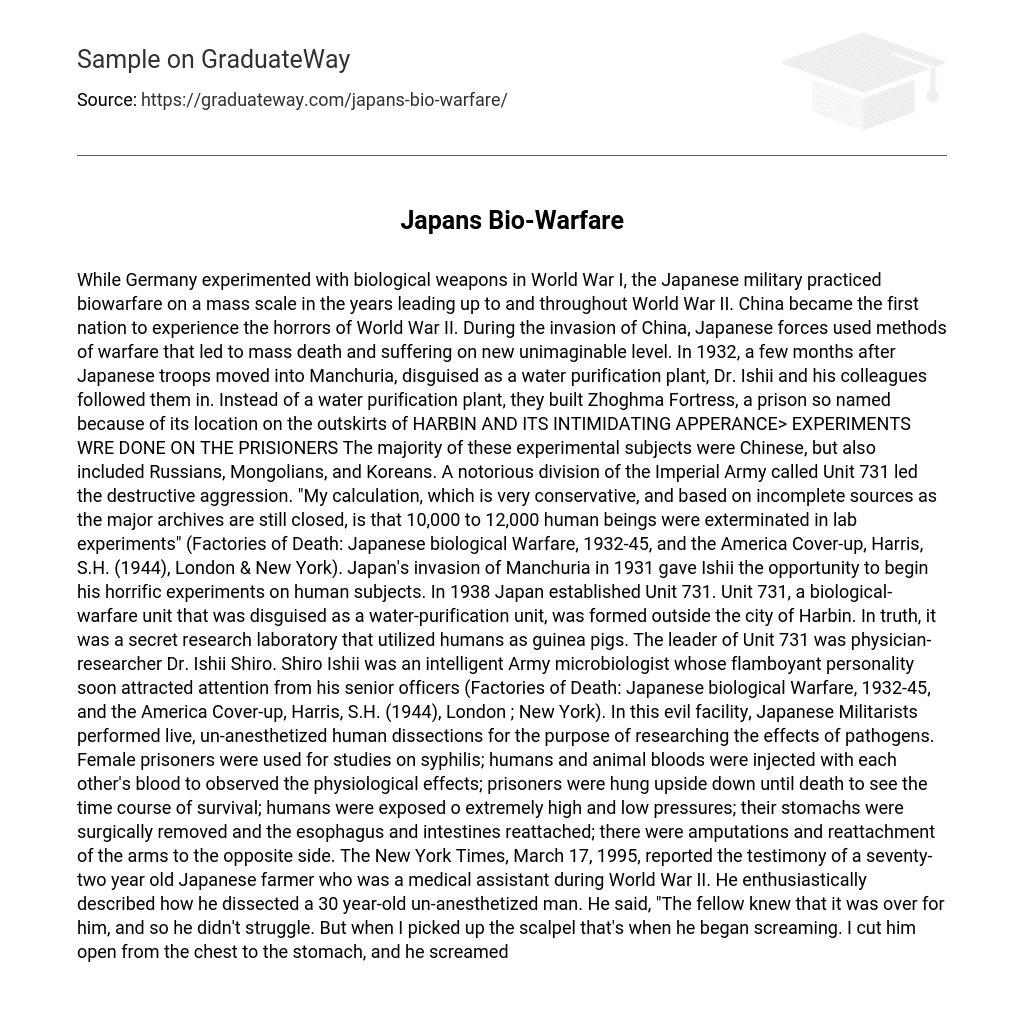Germany conducted experiments with biological weapons during World War I. Furthermore, the Japanese military participated in extensive biowarfare both before and during World War II. Notably, China was the first nation to witness the horrors of World War II.
The invasion of China by Japanese forces during which strategies of warfare were employed resulting in widespread death and suffering at an unprecedented level is a topic of discussion. In 1932, Japanese troops arrived in Manchuria disguised as a water purification plant, but instead established the Zhoghma Fortress on the outskirts of HARBIN with its intimidating appearance. This prison became known for conducting cruel experiments on predominantly Chinese prisoners, as well as Russians, Mongolians, and Koreans. These destructive acts of aggression were spearheaded by Unit 731, a notorious division of the Imperial Army.
According to the book “Factories of Death: Japanese biological Warfare, 1932-45, and the America Cover-up” by S.H. Harris (1944) in London & New York, the author conservatively estimates that around 10,000 to 12,000 individuals were exterminated in laboratory experiments. However, these calculations are based on incomplete sources due to the closure of major archives. The opportunity for these horrific experiments arose when Japan invaded Manchuria in 1931. At that time, Unit 731 was established by Japan in 1938. Despite being disguised as a water-purification unit, Unit 731 was actually a secret research laboratory that conducted experiments on humans.
The head of Unit 731 was Dr. Ishii Shiro, a physician-researcher. Dr. Shiro Ishii was a brilliant Army microbiologist whose extravagant character quickly caught the eye of his superiors (Factories of Death: Japanese biological Warfare, 1932-45, and the America Cover-up, Harris, S.H. (1944), London ; New York). Within this malevolent establishment, Japanese Militarists conducted live human dissections without anesthesia in order to study the impacts of pathogens.
During World War II, female prisoners endured cruel experiments such as syphilis studies and the observation of injecting human and animal bloods. Additionally, researchers determined survival time by hanging prisoners upside down until death. Humans were subjected to extreme high and low pressures, while surgical procedures like stomach removal and reattachment of the esophagus and intestines were performed. There were also instances where arms were amputated and reattached on the opposite side.
On March 17, 1995, The New York Times shared the testimony of a seventy-two year old Japanese farmer who worked as a medical assistant during that period. He vividly recounted witnessing the dissection of a 30-year-old man without anesthesia. Astonishingly, despite enduring such a gruesome fate, the man seemed to accept it without resistance.
Upon picking up the scalpel, the individual commenced screaming as a result. They proceeded to cut the person open, starting from the chest and extending to the stomach, causing agonizing screams and a contorted face expressing immense pain. The individual emitted an indescribable sound, horrifyingly screaming. However, eventually, they ceased their shrieks.” The unnamed former medical assistant divulged the motivation behind the vivisection. It was due to a research endeavor where the Chinese prisoner had intentionally been infected with the plague.
Sheldon Harris’s book, “Factories of Death”, reveals various inhumane experiments conducted on subjects. These experiments involved suspending individuals upside down to measure the time it took for them to suffocate, injecting air into them to observe embolism onset, and injecting horse urine into their kidneys. Dr. Kanisawa expressed initial reluctance in obeying the instructions given to him.
In his book titled “Unit 731: Testimony; Japan’s Wartime Human Experimentation and the Post-War Cover-Up,” author Hal Gold provides an overview and detailed description of the Imperial Japanese Army’s most notorious medical unit. Gold constructs a portrait of this unit, highlighting its history and recounting its most shocking activities. The quote from Harris’s “Factories of Death: Japanese Biological Warfare, 1932-45, and the America Cover-up” reveals the author’s reflection on the aftermath of these actions, emphasizing the lack of nightmares despite the disturbing acts committed with his hands.
One of the testimonies was given by an elderly former Japanese doctor named Kurumizawa Masakuni. He revealed that during a vivisection, a Chinese woman victim regained consciousness. She opened her eyes and started to yell. When asked what she said, Kurumizawa could not respond immediately. He began weeping softly and muttered that he did not want to think about it again. After apologizing, the interviewer waited for a few seconds and asked again. Kurumizawa, while sobbing, managed to give an answer. The woman said, “It’s all right to kill me, but please spare my child’s life.” Unfortunately, not only Chinese, Russians, Mongolians, and Koreans but also US POWs became victims of Unit 731’s experiments. Art Campbell described his experience being frozen for twenty-four hours and subsequently being thawed out in a hot room.
“They froze me until I was unconscious. I could not describe how much it hurt. It hurt so much that I begged the Japanese to kill me,” said Art Campbell, a US POW and survivor of Mukuden (Testimony of Art Campbell, adopted from NBC Dateline “Factory of Death: Unit 731” August 15, 1995). The horrors of Unit 731 were not limited to adults. According to a report by The New York Times on March 17, 1995, children were also targeted as subjects. The unit would randomly snatch civilians from the streets, including a 10-year-old boy who was kidnapped in 1943 and brought to the laboratory dissection table.
A individual wearing a white cap performed a Y-incision on his chest. Blood initiated dripping from his chest. In under 60 minutes, his stomach, kidneys, liver, pancreas, and intestines were stored in jars of formaldehyde. Due to their freshness, the organs were still exhibiting movement and emitting gentle sounds. At that moment, somebody exclaimed, “Hey, the organs are still alive.” Subsequently, everyone burst into laughter. His brain did not go to waste.
Everything was preserved except for the boy’s extremities and empty abdominal cavity.





